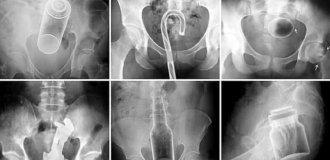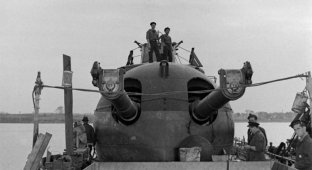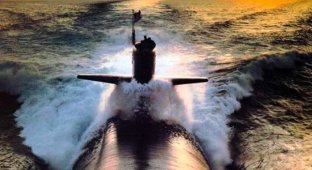The idea of the combat use of an underwater vessel was first expressed by Leonardo da Vinci. He subsequently destroyed his project because he feared the devastating consequences of submarine warfare. Sometimes among the prototypes of submarines they also call “gulls”, elongated boats of the Zaporozhye Cossacks, which could be used in an inverted state.

The first true submarine to see action was created in the United States by Horace L. Hunley in the Confederate Navy during the Civil War. It was a locomotive boiler, with pointed ends mounted on both ends. The dive was carried out by filling two ballast tanks at the bow and stern, which were purged with hand pumps for ascent, and for an urgent ascent, iron ballast attached to the bottom was dropped. The propeller was rotated by eight sailors using a crankshaft. The armament consisted of a mine mounted on a long steel pole at the bow of the boat. Observation, entry and exit of the crew from the boat was carried out through two small turrets.
Horace L. Hunley in the Confederate Navy
World War I
In May 1899, at an international conference in The Hague, Russia, with the support of countries such as Germany, France, Italy, Japan and the United States, attempted to limit the creation of underwater weapons, which was thwarted by Great Britain.
English submarines. Portsmouth. First decade of the twentieth century.
During the First World War, submarines appeared with a diesel engine for movement on the surface, and an electric engine for movement under water. A generator was connected to the diesel engine, which produced electricity to recharge the batteries.
The accelerated development of the submarine fleet during the First World War led to the fact that submarines became a formidable weapon. In total, during the war, 600 submarines of the warring states sank 55 large warships (battleships and cruisers), 105 destroyers, and 33 submarines. The total carrying capacity of sunk merchant ships was about 19 million register tons. The actions of German submarines on sea lanes brought England to the brink of defeat in the war.
English submarines. Portsmouth. First decade of the twentieth century.

German UC-1. World War I

Mine (torpedo) compartment of a submarine from the First World War

Based on the results of the First World War, the conclusion was made about the need for interaction between submarines and surface ships of squadrons, therefore, in the period between the world wars, surface tactical and technical characteristics were mainly improved.
The Second World War
By the beginning of World War II, the fleets of the leading maritime powers included the following number of submarines:
Germany - 57;
USA - 99;
France - 77;
Italy - 105;
Japan - 56;
USSR - ~200, by 06/22/1941 - 211.
Great Britain - 58;
During the war, all submarines of foreign countries (except the USSR) sunk 4,330 transport ships with a total capacity of about 22.1 million tons. tons, 395 warships were destroyed, including: 75 submarines, 17 aircraft carriers, 3 battleships, 122 destroyers and 146 ships of other types. 1,123 submarines were lost.
Submarines of the USSR Navy sank 328 transports, 70 warships and 14 auxiliary ships of the enemy with a total displacement of 938 thousand tons.
During the Second World War, submarines performed different tasks, but with relatively identical combat capabilities, the effectiveness of their actions was uneven. In extremely difficult conditions, in cramped and shallow areas, in the presence of a serious mine danger and a highly developed anti-submarine defense, Soviet submarines had to solve combat missions.
L-23 is a Soviet diesel-electric mine-torpedo submarine of the Second World War, the fourth ship of the XIII-1938 series of the Leninets class.

L-19 (series XIII, L - "Leninets") - Soviet diesel-electric underwater minelayer of the Second World War.

Submarines of the M type - "Malyutka" - a type of Soviet submarine from the Second World War, the smallest submarines in the Soviet Union during this period. Submarines of the "M" type actively participated in the Great Patriotic War. Intended for close-in defense of coasts and naval bases, they were capable of conducting successful combat operations even off the enemy’s coast, in enemy harbors.


WWII submarines of other countries:
American submarine, Argonaut type

German submarines Series "VII"

U-36 (killed in 1939)

U-28 (killed 17.3.1944), U-29 (sunk 5.5.1945), U-30 (sunk 5.5.1945)

IN NEW QUALITY
Work on the creation of nuclear submarines was carried out at an accelerated pace. In 1948, the design of a nuclear power plant was completed and a contract was signed for the design and construction of an experimental reactor, and in August 1949, the tactical and technical data of the first nuclear submarine, which was laid down in June 1952 at the shipyard in Groton and named Nautilus, was approved. On January 21, 1954, in the presence of US President Eisenhower, the Nautilus was launched, and on January 18, 1955, it went out for testing and the commander broadcast in clear text “We are going under the atomic engine.”
USS Nautilus (SSN-571) was the world's first nuclear submarine, launched in the United States in 1954.

The first nuclear submarines not only demonstrated their tactical advantages, but also raised a number of problems. Thus, their displacement has approximately doubled, and their cost has increased by almost twenty times in comparison with US diesel-electric submarines of the Second World War.

When creating nuclear submarines, it was necessary to fundamentally change the approach to choosing the shape and size of the hull, which for diesel-electric submarines were determined based on the surface navigation mode. For a nuclear submarine that is almost constantly under water, the surface mode is episodic, and, therefore, when creating it, it is necessary to strive to reduce the resistance of the boat in a submerged position as much as possible. Despite some success in reducing the underwater resistance of diesel-electric. boats built in the mid-40s - early 50s, their hull shape and dimensions were not suitable for nuclear submarines. More radical measures were required, since we were talking about underwater speeds of about 30 knots or more, at which water resistance would “eat up” a significantly larger share of the power plant’s power than on diesel-electric boats with an underwater speed of 10-15 knots. And the increase in power for every 1000 kW, taking into account the low specific mass indicators of the nuclear power plant, was accompanied by an increase in the mass of the installation by approximately 80 tons.
In the USSR, the first nuclear submarine was the well-known K-19.
"K-19" was capable of carrying three nuclear ballistic missiles. The submarine was built in Sverdlovsk in record time and became the Soviet Union's response to the appearance of the American missile submarine George Washington.
Design within the framework of Project 658 began in August 1956 at TsKB-18 under the leadership of S.N. Kovaleva. Project 627 nuclear-powered multi-purpose torpedo boat was taken as the basis.
K-19 is a Project 658 nuclear submarine. Due to numerous accidents, the boat had the nickname “Hiroshima” in the navy.



List of accidents and disasters on K-19
Due to accidents, several people died in 1959 even before the submarine was launched:
while painting the holds, a fire broke out, two people died;
after painting work resumed, a female painter suffocated;
In 1961, while loading missiles into silos, one sailor was crushed under the silo lid and died.
On April 12, 1961, the boat miraculously avoided a collision with the nuclear submarine USS Nautilus SSN-571, but due to a sharp maneuver to reduce the depth, it crashed into the bottom. There was no significant damage.
July 3, 1961 - aft reactor accident: a drop in pressure in the primary circuit as a result of a rupture in the primary circuit of the impulse tube between the pressure line and the sensors. As a result, the instruments showed zero pressure, although there was no complete rupture. Elimination of the accident subsequently cost the lives of 8 people; all other crew members received high doses of radiation.
November 15, 1969 - an underwater collision with the US Navy submarine USS Gato during a maneuver changing the depth from 60 to 90 meters.
February 24, 1972 - fire in compartments 8 and 9. Towed to base. 28 people on the boat and 2 rescuers died. 12 sailors were imprisoned in the 10th aft compartment for 24 days without light, communications, food and with meager supplies of water, receiving only air from other compartments (intermittently). Everyone survived.
August 15, 1982 - During repairs, an electric arc occurred in the battery compartment. Several people were burned, one of them died in hospital on August 20.
Modern submarines
Modern submarines use nuclear power plants, diesel engines, batteries, Stirling engines or fuel cells as a power source.
Submarine on a voyage
Since the end of World War II, only two reliable cases of a warship being torpedoed by a submarine are known. On December 9, 1971, during the Indo-Pakistani War, the Pakistani diesel submarine Hangor torpedoed the Indian frigate Khukri. On May 2, 1982, during the Falklands War between Great Britain and Argentina, the British nuclear submarine Conqueror torpedoed the Argentine light cruiser General Belgrano. In addition, the death of the South Korean corvette Cheonan on March 26, 2010, occurred, according to the conclusion of the commission investigating the incident, as a result of its torpedoing by a North Korean submarine.
Vanguard class nuclear submarine.


Missile submarine cruiser pr.941 “Typhoon.”


dаta:
The most revolutionary submarine.
Project 705 - Lyra
Submarines of projects 705, 705K "Lira" are a series of Soviet nuclear submarines. High-speed small single-shaft boats with a titanium hull had no analogues in speed and maneuverability and were designed to destroy enemy submarines. Difficulties in maintaining these submarines and a reduction in funding due to the start of restructuring led to the end of the career of these ships.

The Lear's maximum speed is 41 knots. They are second in speed only to the withdrawn K-222 project 661 “Anchar”, which set a record speed of 44.7 knots;
For more than 20 years of service, not a single person died in the fight for survivability. None of the ships were lost;
"Lears" could pursue any submarine and break away from any pursuit. It took them only about 1 minute to accelerate to full speed.
The speed of the boat allowed it to escape even from many anti-submarine torpedoes.
The world's only serial nuclear submarine project with a liquid metal reactor
The boat of this project set a record for average daily speed of ~ 41-42 knots.

The deepest
K-278 “Komsomolets”
K-278 "Komsomolets" is a Soviet nuclear submarine of the 3rd generation, the only boat of Project 685 "Plavnik". The boat holds the absolute record for diving depth among submarines - 1027 meters[1]. Died in a fire in the Norwegian Sea on April 7, 1989.


The most widespread
U-Boot Class VII (Germany)
The class 7 submarine is known not only for its record number of units (703 units entered service during WWII), but also for its remarkable performance.

The deadliest
Project 949A "Antey"
Project 949A Antey submarines are a series of Soviet and Russian submarines with Granit cruise missiles. According to NATO classification - “Oscar-II”. The main purpose of the class is the destruction of aircraft carrier strike formations. The project is a modification of type 949 “Granite”. A total of 11 ships out of 18 planned were built, the construction of one was mothballed, the rest were cancelled.
A huge ship with an underwater displacement of 24,000 tons carries 24 cruise missiles on board. One of the 11 ships of the Antey project was the K-141 Kursk, which tragically died on August 12, 2000 in the Barents Sea.
Project 949A "Antey". Nuclear submarine "Smolensk".


The most terrifying
SSBN-598 "George Washington"
With its appearance, the first nuclear-powered missile carrier "George Washington" completed the formation of the classical nuclear triad - a modern mechanism of nuclear deterrence, in which the state's strategic arsenal is deployed on land, at sea and in the air. The ship carried 16 UGM-27 Polaris two-stage ballistic missiles and could launch them from a depth of 20 meters. 

The largest submarine
Project 941 "Shark"
Heavy strategic missile submarines of Project 941 "Akula" (SSBN "Typhoon" according to NATO classification) are the largest nuclear submarines in the world. The project was developed at the Rubin Central Design Bureau of Mechanical Engineering (St. Petersburg). The development order was issued in December 1972.

Underwater displacement 49500, length: 172.8 m, crew 160 people.

The main armament is the D-19 missile system with 20 R-39 Variant three-stage solid-fuel ballistic missiles. These missiles have the largest launch weight (together with the launch container - 90 tons) and length (17.1 m) of the SLBMs put into service. The combat range of the missiles is 8300 km, the warhead is multiplex: 10 warheads with individual guidance of 100 kilotons of TNT each.

Interesting Facts:
The commander of the first missile cruiser, Captain 1st Rank A.V. Olkhovikov, was awarded the title of Hero of the Soviet Union in 1984 for mastering a unique ship.
The displacement of the nuclear submarine of the Akula project is greater than the displacement of the heavy aircraft-carrying cruiser Admiral Gorshkov.
6 nuclear submarines of the Akula project are listed in the Guinness Book of Records as the largest submarines in the world.
The commander's seat in the central post is inviolable, including for the commanders of a division, fleet or flotilla, and even the Minister of Defense.

























